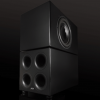Overview of DTV Transition
The digital television (DTV) transition refers to the switch from analog to digital broadcast television. When the DTV transition is completed on February 17, 2009, all U.S. full-power TV stations will stop broadcasting in analog format, and will transmit only in digital instead. After that time, consumers who subscribe to pay television services (for example: cable, satellite) will continue to receive broadcast (“over the air”) television programs through these subscription services. Consumers who do not have subscription TV services will have two choices: 1 they can purchase a digital TV (either a stand alone digital TV or separate digital tuner set-top box) or 2 they can acquire a digital-to-analog converter box for each of their analog TVs to continue receiving free over-the-air digital television programming. The converter box will convert the over-the-air digital signals into signals that analog TV sets can receive and display. Starting in 2008, a government program run by a separate agency — the National Telecommunications and Information Administration (NTIA) — will make available $40 coupons, two per household, to help consumers pay for converter boxes. More information on the digital-to-analog converter box coupon program is available online at www.ntia.doc.gov/dtvcoupon/index.html, or by calling 1-888-DTV-2009 (voice) or 1-877-530-2634 (TTY).
Some consumers have expressed concern about how the converter boxes will work and whether consumers will continue to receive closed captions after the transition to digital television takes place. The Federal Communications Commission (FCC) wishes to reassure consumers that its rules do require digital-to-analog converter boxes to pass through closed captions. This advisory explains how consumers will be able to access closed captions using these converter boxes.
Closed Captioning and the Digital-to-Analog Converter Box
Closed captioning displays the audio portion of a television program as text on the television screen, enabling people with hearing loss and others to better access television programming. FCC rules require DTV equipment such as converter boxes to be capable of passing through closed captioning. The digital-to-analog converter box receives closed caption signals and passes those closed caption signals to your TV automatically. In addition, many converter boxes will generate captions through the converter box itself, thus enabling you to change the way your captions look.
How to Control Closed Captions Through Your TV
Analog TVs that are 13 inches or larger, and were manufactured after July 1993, can display closed captions. When using any digital-to-analog converter box on one of these TVs, you can follow the instructions that came with your TV to turn closed captions on/off through your TV or TV remote control, just as you always have. If you were able to see closed captions on your TV before you got the converter box, you will continue to see closed captions on your TV the same way after attaching the box. As before, captions will appear as white text on a black background.
Analog TVs that are smaller than 13 inches and TVs manufactured before July 1993, are not required to display closed captions. If your converter box is equipped to generate closed captions itself, however, you may be able to see closed captions on these TVs by following the instructions below.
How to See Closed Captions Through Converter Boxes Equipped Themselves to Generate Closed Captions
In addition to passing through closed caption signals, many converter boxes also include the ability to take over the captioning role that the tuner plays in your analog TV set. To determine whether your converter box is equipped to generate captions in this way, you should refer to the user manual that came with the converter box. If your converter box is equipped to generate captions in this way, then follow the instructions that came with the converter box to turn closed captions on/off via your converter box or converter box remote control. When you access the closed captions in this way, you also will be able to change the way your digital captions look. The converter box will come with instructions on how to change the caption size, font (style), caption color, background color, and opacity. This ability to adjust your captions is something you cannot do now with an analog television and analog captions.
What To Do if You Have Problems with Getting Captions
If you turn on the digital-to-analog converter box and see a double row of overlapping captions, it may mean you are seeing captions through both your TV and your digital-to-analog converter box. You should turn off the closed captioning function either on your television or on the converter box.
If you are able to get captions when you tune to one station, but not another, most likely this is not a problem with your converter box. You should contact the television station airing the program that does not have captions.
If you are using a digital-to-analog converter box with an analog TV set and cannot see any captions, you should contact the manufacturer of the converter box.
Filing a Complaint with the FCC
If you have tried to resolve your problem viewing closed captioning in any of these ways but it continues, you can file a complaint with the FCC alleging a violation of the Television Decoder Circuitry Act and the FCC’s implementing rules. There is no charge for filing a complaint. If your complaint concerns the inability of your converter box to deliver captions, you may complain directly to the FCC. If your complaint concerns the lack of captioning on a specific program or channel (i.e., you receive captions on some channels, but not others), you must first complain to the programming distributor (meaning the broadcast TV station). For more information on filing a complaint with your programming distributor and the information to include in such complaints, see the FCC’s closed captioning consumer fact sheet at www.fcc.gov/cgb/consumerfacts/closedcaption.html. If you are uncertain where to file your complaint, contact the FCC’s Consumer Center using the contact information provided for filing a complaint with the FCC below.
You can file your complaint with the FCC using the FCC’s on-line complaint Form 2000C found on the FCC Web site at www.fcc.gov/cgb/complaints.html. You can also file your complaint with the FCC’s Consumer Center by e-mailing fccinfo@fcc.gov; calling 1-888-CALL-FCC (1-888-225-5322) voice, 1-888-TELL-FCC (1-888-835-5322) TTY; faxing 1-866-418-0232; or writing to:
Federal Communications Commission
Consumer & Governmental Affairs Bureau
Consumer Inquiries and Complaints Division
445 12th Street, S.W.
Washington, DC 20554.
What to Include In Your Complaint to the FCC
The best way to provide all the information the FCC needs to process your complaint is to complete fully the on-line complaint Form 2000C. If you do not use the on-line complaint Form 2000C, your complaint, at a minimum, should indicate:
- your name, address, email address, and phone number where you can be reached;
- whether you are filing a complaint on behalf of another party, and, if so, the party’s name, address, email address, day time phone number, and your relationship to the party;
- preferred format or method of response (letter, fax, voice phone call, email, TRS, TTY, ASCII text, audio recording, or Braille);
- that your complaint is about closed captioning for DTV;
- the name, address, and telephone number (if known) of the company or companies involved in your complaint;
- the date and time or other details about timing of the lack of closed captioning;
- television station call sign (WZUE), TV channel (13), location (city and state), and name of program involved; and
- a brief description of your complaint and the resolution you are seeking, and a full description of the equipment or service you are complaining about, including date of purchase, use, or attempt to use.
For More Information
For more information about the DTV transition, visit www.dtv.gov, and see the FCC’s consumer fact sheets at www.fcc.gov/cgb/consumerfacts/digitaltv.html and www.fcc.gov/cgb/consumerfacts/dtvcaptions.html. You can also contact our the FCC’s Consumer Center using the contact information provided for filing a complaint.





























